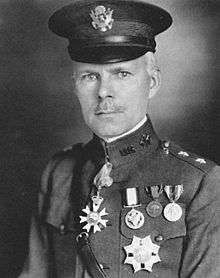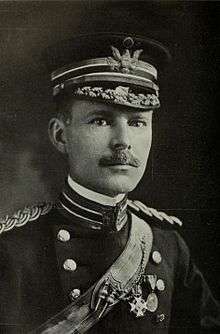George Owen Squier
| Chief Signal Officer, U.S. Army George Owen Squier | |
|---|---|
 Major General George Owen Squier | |
| Born |
March 21, 1865[1] Dryden, Michigan |
| Died |
March 24, 1934 (aged 69) Washington, D.C. |
| Buried | Arlington National Cemetery |
| Allegiance |
|
| Service/ |
|
| Years of service | 1887–1923 |
| Rank |
|
| Commands held | Chief Signal Officer |
| Battles/wars |
Spanish–American War World War I |
| Awards |
Distinguished Service Medal Honorary Knight Commander of the Order of St Michael and St George Order of the Crown of Italy Legion of Honor Elliott Cresson Medal John Scott Medal Franklin Medal |
| Other work | businessman, scientist |
Major General George Owen Squier (March 21, 1865 – March 24, 1934) was born in Dryden, Michigan, United States.[1] He graduated from the United States Military Academy in the Class of 1887 and received a Ph.D. from Johns Hopkins University in 1893.
Life and military career

George Squier wrote and edited many books and articles on the subject of radio and electricity. An inventor, he and Dartmouth professor Albert Cushing Crehore developed a magneto-optical streak camera "The Polarizing Photo-chronograph" in 1896 to measure the speed of projectiles both inside a cannon and directly after they left the cannon barrel. This was one of the earliest photonic programs. They also worked to develop synchronous AC telegraphic systems. His biggest contribution was that of telephone carrier multiplexing in 1910 for which he was elected to the National Academy of Science in 1919.
As executive officer to the Chief Signal Officer, U.S. Signal Corps in 1907, Squier was instrumental in the establishment of the Aeronautical Division, U.S. Signal Corps, the first organizational ancestor of the US Air Force.[2] He also was the first military passenger in an airplane on September 12, 1908 and, working with the Wright Brothers, was responsible for the purchase of the first airplanes by the US Army in 1909.
From May 1916 to February 1917, he was Chief of the Aviation Section, U.S. Signal Corps, the first successor of the Aeronautical Division, before being promoted to major general and appointed Chief Signal Officer during World War I.[3]
In 1922, he created Wired Radio, a service which piped music to businesses and subscribers over wires. In 1934, he changed the service's name to 'Muzak'.
Asked how to say his name, he told The Literary Digest it was pronounced like the word square.[4]
He was a member of the Sons of the American Revolution.
Death
He died in Washington, D.C., at George Washington Hospital[5] on March 24, 1934[6] of pneumonia.
Awards
- Distinguished Service Medal
- Spanish War Service Medal
- Philippine Campaign Medal
- World War I Victory Medal
- Honoary Knight Commander of the Order of St Michael and St George
- Commander of the Legion of Honor (France)
- Commander of the Order of the Crown of Italy
Dates of rank
| No Insignia | Cadet, United States Military Academy: 1 July 1883 |
| No Insignia in 1886 | Second Lieutenant, Regular Army: 12 June 1887 |
| First Lieutenant, Regular Army: 30 June 1893 | |
| Captain, Volunteer Army: 1 June 1898 (Date of rank was 20 May 1898.) | |
| Lieutenant Colonel, Volunteer Army: 20 July 1898 | |
| First Lieutenant, Regular Army: 7 December 1898 (Reverted to permanent rank.) | |
| Captain, Volunteer Army: 17 April 1899 | |
| Captain, Regular Army: 1 July 1901 (Date of rank was 2 February 1901.) | |
| Major, Regular Army: 2 March 1903 | |
| Lieutenant Colonel, Regular Army: 17 March 1913 | |
| Brigadier General, Temporary: 14 February 1917 | |
| Colonel, Regular Army: 12 April 1917 | |
| Major General, Temporary: 8 October 1917 | |
| Colonel, Regular Army: 14 February 1921 (Reverted to permanent rank.) | |
| Major General, Temporary: 28 March 1921 (Date of rank was 6 October 1917.) | |
| Major General, Retired list: 31 December 1923 | |
Legacy
In 1943, the U.S. Navy named troopship USS General G. O. Squier (AP-130) in his honor. It was the lead ship of its class, which was known as General G. O. Squier class of transport ships.
General Squier Park, a historic district and waterpark in his hometown of Dryden, Michigan, is named in his honor.[7][8]
Publications
- Crehore, Albert Cushing; George Owen Squier (1897). The Polarizing Photo-Chronograph. London: John Wiley & Sons.
- — (1908). "The Present Status of Military Aeronautics". Annual Report of the Board of Regents of the Smithsonian Institution: 117. Retrieved 2009-08-07.
- — (1919). Multiplex Telephony And Telegraphy By Means Of Electric Waves Guided By Wires. Washington: Government Printing Office.
References
- 1 2 "Biographical Memoir of George Owen Squier 1865-1934", by Arthur E. Kennelly, National Academy of Sciences of the United States of America, Biographical Memoirs Volume XX, presented to the Academy at the Annual Meeting, 1938. Retrieved Apr 1, 2010.
- ↑ Davis, Jr., Henry Blaine (1998). Generals in Khaki. Pentland Press, Inc. p. 346. ISBN 1571970886. OCLC 40298151.
- ↑ Davis, Jr., Henry Blaine (1998). Generals in Khaki. Pentland Press, Inc. p. 346. ISBN 1571970886. OCLC 40298151.
- ↑ Funk, Charles Earle (1936). What's the name, please? A guide to the correct pronunciation of current prominent names. New York: Funk & Wagnalls. OCLC 1463642.
- ↑ Associated Press, "Former Leader of Air Service Dies, The San Bernardino Daily Sun, San Bernardino, California, Sunday 25 March 1934, Volume 40, page 1.
- ↑ Davis, Jr., Henry Blaine (1998). Generals in Khaki. Pentland Press, Inc. p. 346. ISBN 1571970886. OCLC 40298151.
- ↑ "Lapeer County Parks". Archived from the original on 2012-04-22.
- ↑ "Archived copy". Archived from the original on 2012-06-01. Retrieved 2011-06-04.